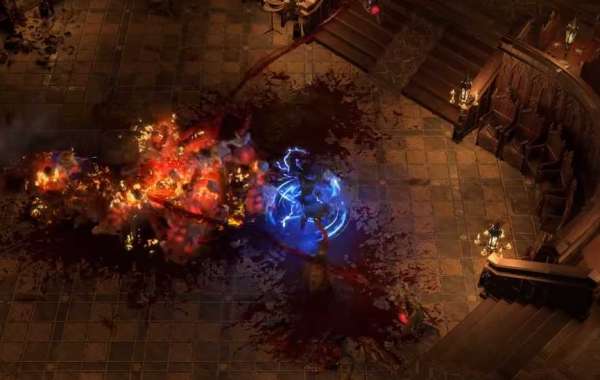This Path of Exile (PoE) 3.10 Path of Exile Delirium League Beginner’s Leveling Guide, Tips and Tricks will be both useful for new and existing players that are trying to speed up their leveling to reach the endgame maps as quick as possible.
POE Delirium League Intro and Classes
Starting off, let’s quickly go over what Path of Exile essentially is. Well, Path of Exile is a free online action role-playing game or ARPG, that’s based in Wraeclast’s mystical world. You are an exile among this fierce world who has the ability to harness tremendous power. Socketing powerful skill gems into your gear and connecting them with supported gems, exiles enjoy the flexibility to select which skill path they want.
You can also communicate, trade, and party with other players during your time in Wraeclast. Or, forget them utterly and play on your own!
This game focuses not solely on the plot but also on the progression and development of your character’s strength when you hit content and bosses from the end game maps. This customization comes from the skill gems you’ve selected, the investments in the expansive passive tree, the ascendancies in your class and, of course, the enormous pool of completely random loot that you’re equipping yourself with (Whether you’ve unearthed it, traded for it or even constructed it yourself!). Yes, not only are the skills totally your choice but so is the gear you choose to wear!
Path of Exile Delirium League Selection and Classes
So the first thing that prompts you is the league in which you want to generate your character. Leagues in Path of Exile come in a few combinations but softcore and hardcore are the only two foundation sets.
In softcore, the player may die as frequently as they want and incur no repercussions, aside from a deterioration of experience based on the difficulty of the zone you are up to a cap of 10 percent. You can’t, however, de-level so it’s not that scary.
In hardcore, the player is eliminated from the league and inserted in the standard softcore league if the character dies.
Now, on top of these fundamental rules, there are also other types of temporary leagues. Initially, these leagues were created as beta testing domains for new game mechanics, however, over time they have become one of the core ways to play the game. Leagues that incorporate new mechanics typically last 3 months, starting with a blank slate for all players including the economy.
New leagues typically arrive with something unique and special about them. This could be new unique items, special missions, or in 3.10 Delirium’s case, cluster Jewels. Such leagues frequently support underlying tasks that players can perform to obtain cosmetic microtransaction prizes, such as footprints or back attachments.
Temporary leagues also come with a standard or Hardcore variant. Once the league has ended all characters and items, each player owns are merged into the standard variant of their chosen league (Standard Softcore or Hardcore).
There are 7 character classes in Path of Exile: The Marauder, The Ranger, The Witch, The Templar, The Shadow, The Duelist, and The Scion. The Scion is unlocked once a player has reached Act Three in the game. Relevant play styles or specific skills don’t characterize these classes strongly. Rather, skills are items socketed in equipment which will determine how your character is played.
It’s worth noting, although you are allowed to utilize any skill and build on any of the seven classes, certain classes make more sense. For example, Rangers’ skill tree starts naturally near a bunch of bow passive points, whereas Marauder starts on the complete opposing side of the passive tree. Therefore, while a Marauder can utilize a bow, they’ll have to invest far more skill points to optimize the build then a Ranger would.
Each class moreover has its own selection of 3 Ascendancy classes, which offer the class additional control and versatility, allowing it to excel in several types of builds.
Classes equally have a certain association attribute based on their position in the tree. These fundamental qualities are Strength, Intelligence and Dexterity. Many classes are based solely on one type of attribute, and others are a two- or three-attribute combination. These attributes offer low, but significant benefits when piled high enough and determine which items and skills can be used.
Path of Exile is critically dependent on the distribution of pseudo-random numbers or RNG, which defines everything from the drops of items to the affixes to the tier of affixes that roll on each of these items, even to the way zones are created. With so many RNG possibilities, searching for specifically rolled items can take Exiles a long time.
One thing that distinguishes Path of Exile from many other games is indeed its currency system. In Path of Exile, there’s no gold, and all currency comes in the form of orbs that can develop or change all items of the four rarities: normal, magical, rare or unique. Depending on how rare the orb is, it will determine its value.
Exiles can make “gold” by exchanging multiple orbs for another type or by selling found or crafted gear in exchange for valuable orbs.
Items in their natural, white, rarity type would have an implicit property right below the item’s name. Items above normal rarity would possess explicit properties or affixes added to them, which will boost the base item.
Affixes are the modifiers presented beneath the base item’s implicit stat. The affixes come as prefixes and suffixes. Any of these rarities can include a certain number of each. The prefixes and suffixes have separate modifier pools, and no two of the same prefix or suffix can roll on the very same item.
PoE Delirium Item rarities
Normal Items – A white base item with no affixes.
Magic Items – Blue items and can have 2 affixes, 1 prefix, and 1 suffix. Their name is generated from the affixes added to it.
Rare Items – Yellow items and can have 6 affixes, 3 prefixes, and 3 suffixes. Their name is generated randomly and retains no affiliation with the affixes added.
Unique Items – Orange items and can have a varying number of affixes and special modifications. Their modifiers, names, and texts are special and developed by supporting players or staff.
Understanding whether an item is valuable it best to use a reliable Delirium Loot Filter to ensure you’re not leaving powerful items laying on the ground. Additionally, Exiles can use PoE.Trade mentioned above to determine the value of each item.
POE Delirium Sockets and Gems
As described earlier, skills are connected to a character class in the form of skill gems, rather than actively learned abilities. These will be items that can be acquired through quests, purchased from NPC vendors or from other players. Many classes will also have access to a subset of gems from their quests and have to purchase the other gems from other players or get them through drops.
To use any skill gem, you will need to insert gems into a piece of equipment that you’re currently wearing. You will insert gems into a piece of equipment that you wear to use these ability jewels. To socket them, you should possess the appropriate level, attribute requirements and socket colors. Sockets will come in three colors: Red (based on strength), Green (based on dexterity), and Blue (based on intelligence). When you have the skill socketed, the ability will show in the lower right-hand corner on your skill bar. To change which hotkey the skill uses, click any of the skill slots and select the newly added skill.
Furthermore, each piece of gear can have multiple sockets, which means more skill gems can be socketed or certain skill gems can be linked to support gems, enhancing the main skill. To support skill with a support gem, the sockets have to be joined together (unless otherwise stated by some unique items). Depending on the color of sockets and the number will determine which skills can be used and how powerful they can be. The number of sockets and colors can be changed using specific currency orbs.
Not all support gems will boost skill gems. A melee support gem will provide no benefits to skills marked as spell and vice-versa. Hover over any support gem and the game will show you a UI notifying all skills you currently use that support the gem.
Your gems also accumulate experience and level as you gain experience. Leveling gems can boost the damage they do, and indeed the respective gem level and attribute requirements. Gems, unlike your character, will not lose experience when the player dies. A valuable tip for leveling gems, place an unused weapon in your weapon swap slot. Gems will continue to gain experience even when the weapon is not in use.
That's all you need to know about Path of Exile Delirium Leveling Guide! If you're a seasoned veteran, we hope you also learned a thing or two more about the different ways to get PoE currency and most importantly—PoE orbs. Most of the time, not everyone has enough time to reach the goal. So, you can Buy Poe Currency to replenish your inventory. Here, I recommend the best PoE currency site — https://www.igvault.com/POE-Currency . It's cheap, safe and fast, very good! Enjoy the Game.








